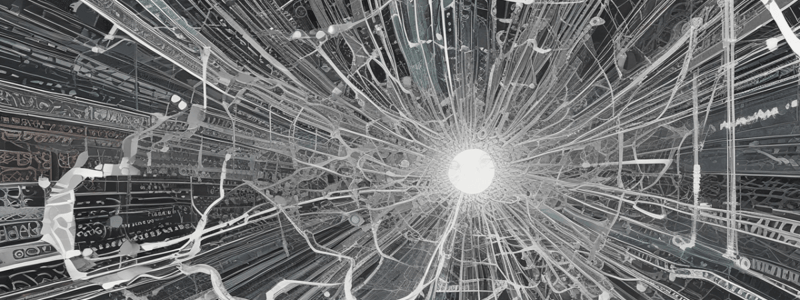Podcast
Questions and Answers
What is the primary function of the Domain Name System (DNS) in the Internet model?
What is the primary function of the Domain Name System (DNS) in the Internet model?
- To send emails directly to the recipient
- To facilitate communication between client and server programs
- To provide a naming system for hosts on the Internet (correct)
- To replace the host file system
What type of paradigm do client/server programs, including DNS, follow?
What type of paradigm do client/server programs, including DNS, follow?
- Peer-to-peer
- Client/server (correct)
- Distributed system
- Centralized system
What is the main limitation of using a host file to map names to addresses?
What is the main limitation of using a host file to map names to addresses?
- It is not updated regularly
- It is not widely used
- It is not scalable (correct)
- It is not secure
What is the role of the DNS client program in the DNS service?
What is the role of the DNS client program in the DNS service?
Why do people prefer to use names instead of IP addresses?
Why do people prefer to use names instead of IP addresses?
What is the main advantage of using DNS over the host file system?
What is the main advantage of using DNS over the host file system?
What is the purpose of the DNS server in the DNS service?
What is the purpose of the DNS server in the DNS service?
What is the consequence of not having a system to map names to addresses?
What is the consequence of not having a system to map names to addresses?
What type of programs use the DNS service?
What type of programs use the DNS service?
What can a central authority assign in a domain name?
What can a central authority assign in a domain name?
What is the maximum number of levels in a domain name space?
What is the maximum number of levels in a domain name space?
What is the maximum number of characters in a label?
What is the maximum number of characters in a label?
How are domain names read?
How are domain names read?
What is a fully qualified domain name (FQDN)?
What is a fully qualified domain name (FQDN)?
Why do domain names always end with a dot?
Why do domain names always end with a dot?
What is the purpose of a central authority in domain name assignment?
What is the purpose of a central authority in domain name assignment?
What is the structure of a domain name space?
What is the structure of a domain name space?
What is the significance of the root label in a domain name space?
What is the significance of the root label in a domain name space?
Why is a centralized DNS system inefficient?
Why is a centralized DNS system inefficient?
What is the main solution to the problems of a centralized DNS system?
What is the main solution to the problems of a centralized DNS system?
How are domains divided in a DNS system?
How are domains divided in a DNS system?
What is a zone in a DNS system?
What is a zone in a DNS system?
What does a server create to store information about every node under its domain?
What does a server create to store information about every node under its domain?
What happens when a server divides its domain into subdomains?
What happens when a server divides its domain into subdomains?
What does a server keep when it divides its domain into subdomains?
What does a server keep when it divides its domain into subdomains?
Why is it not possible to store the complete domain name hierarchy on a single server?
Why is it not possible to store the complete domain name hierarchy on a single server?
What is the term for a server that is responsible for a domain?
What is the term for a server that is responsible for a domain?
What is the purpose of the identification subfield in the DNS header?
What is the purpose of the identification subfield in the DNS header?
What is the format of both query and response messages?
What is the format of both query and response messages?
What is the size of the DNS message header?
What is the size of the DNS message header?
What is the purpose of the flags subfield in the DNS header?
What is the purpose of the flags subfield in the DNS header?
What is present in the question section of a DNS message?
What is present in the question section of a DNS message?
What is the value of the number of answer records subfield in a query message?
What is the value of the number of answer records subfield in a query message?
What is the purpose of periodically searching the cache memory?
What is the purpose of periodically searching the cache memory?
What type of messages does DNS have?
What type of messages does DNS have?
What determines the type of answer requested in a DNS message?
What determines the type of answer requested in a DNS message?
What happens when a server serves the whole site?
What happens when a server serves the whole site?
How is an IP address like 132.34.45.121 read in a domain name?
How is an IP address like 132.34.45.121 read in a domain name?
What is name-address resolution?
What is name-address resolution?
What is the role of a resolver in DNS?
What is the role of a resolver in DNS?
What does a resolver do when it receives a response from a DNS server?
What does a resolver do when it receives a response from a DNS server?
What type of domain name does a resolver receive from the generic domains section?
What type of domain name does a resolver receive from the generic domains section?
What happens if a local DNS server cannot resolve a query?
What happens if a local DNS server cannot resolve a query?
What type of domain name does a resolver receive from the country domains section?
What type of domain name does a resolver receive from the country domains section?
What is the final step of the resolver?
What is the final step of the resolver?
Flashcards are hidden until you start studying
Study Notes
Introduction to Domain Name System (DNS)
- The DNS is a supporting program that is used by other programs such as e-mail to map a name to an IP address or vice versa.
- DNS client/server program supports an e-mail program to find the IP address of an e-mail recipient.
DNS Functionality
- DNS maps a name to an IP address or an IP address to a name.
- People prefer to use names instead of numeric addresses, so DNS is necessary.
- DNS is used to identify an entity, as TCP/IP protocols use IP addresses to uniquely identify a host on the Internet.
DNS History
- In the early days of the Internet, mapping was done using a host file with two columns: name and address.
- Host files were stored on every host and updated periodically from a master host file.
- With the growth of the Internet, it became impossible to have one single host file to relate every address with a name and vice versa.
Domain Name Space
- A domain name space was designed to have a hierarchical name space with an inverted-tree structure with the root at the top.
- The tree can have up to 128 levels: level 0 (root) to level 127.
- Each node in the tree has a label, which is a string with a maximum of 63 characters.
- Children of a node have different labels, guaranteeing the uniqueness of domain names.
Domain Name
- A full domain name is a sequence of labels separated by dots (.)
- Domain names are always read from the node up to the root.
- The last label is the label of the root (null), so a full domain name always ends in a null label.
Fully Qualified Domain Name (FQDN)
- A label terminated by a null string is called a Fully Qualified Domain Name (FQDN).
- FQDN is inefficient and unreliable because it places a heavy load on the system and any failure makes the data inaccessible.
Hierarchy of Name Servers
- The solution to the problems of FQDN is to distribute the information among many computers called DNS servers.
- DNS servers are divided into many domains based on the first level, creating a hierarchy of servers.
- Each server is responsible (authoritative) for either a large or a small domain.
- A zone is a contiguous part of the entire tree, and a server makes a database called a zone file and keeps all the information for every node under that domain.
Resolution
- Mapping a name to an address or an address to a name is called name-address resolution.
- A host that needs to map an address to a name or a name to an address calls a DNS client called a resolver.
- The resolver accesses the closest DNS server with a mapping request, and the server either satisfies the resolver or refers the resolver to other servers.
DNS Messages
- DNS has two types of messages: query and response.
- Both query and response messages have the same format with some fields set to zero for the query messages.
- The header is 12 bytes, and its format includes identification subfield, flags subfield, and number of question/answer/authoritative/additional records subfields.
- The question section consists of one or more question records, and it is present in both query and response messages.
Studying That Suits You
Use AI to generate personalized quizzes and flashcards to suit your learning preferences.




